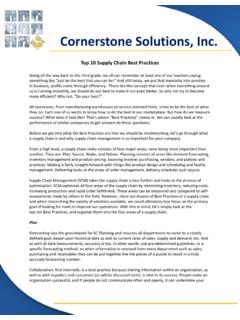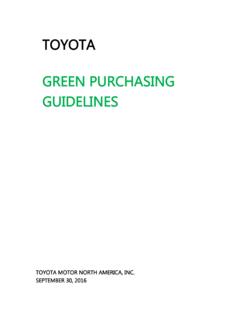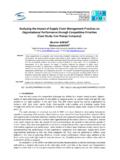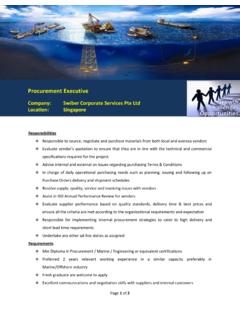Transcription of 4 b content purchasing inventory - WHO
1 purchasing & inventory Module 4 content Sheet 1 content Sheet 4-1: purchasing and inventory Overview Role in quality management systems purchasing and inventory management is a critical, or essential, component of the quality management system. Efficient and cost-effective laboratory operations need the uninterrupted availability of reagents, supplies, and services. Inability to test, even for a short time, is very disruptive to clinical care, prevention activities, and public health programs. Benefits Careful management of inventory helps to prevent waste, which can occur if reagents and supplies are stored improperly, or if reagents become out-dated before they can be used. Establishing a purchasing and inventory management program will ensure that: supplies and reagents are always available when needed; high quality reagents are obtained at an appropriate cost; reagents and supplies are not lost to improper storage or kept and used beyond expiration.
2 Considerations Methods for obtaining reagents and supplies vary considerably between laboratories. Some laboratories may purchase directly, but, in many countries, a national procurement system is in place, with a central stores area that distributes directly to the laboratories. Also, in many places, donors have a major role in the procurement of supplies and reagents. The laboratory system for managing the reagents and supplies must take into account these variables. purchasing & inventory Module 4 content Sheet 2 Challenges The challenge of inventory management is balancing the availability of supplies and reagents in stock with their expiration dates. The life-span of reagents can vary from a few weeks to a number of years. It is important to continuously monitor the expiration dates to make sure needed reagents are always on hand and have not expired.
3 However, it is too costly and wasteful to overstock. Equipment and supplies received or accepted from donors must meet the clients' and operational needs of the laboratory. Managers may sometimes need to refuse donations, but this should be done in a diplomatic way to ensure future offers are not discouraged. Key components Successful purchasing and inventory management requires that policies and procedures be established for managing all critical materials and services. Some of the key components to address are: vendor/manufacturer qualifications; purchase agreements; receiving, inspecting, testing, storing, and handling of materials; all purchased material should be inspected and appropriately tested to ensure that specifications are met. Policies should be established for storing and handling materials as they are delivered to the laboratory. tracking materials to individual patients; the management system must allow for tracking materials to individual patients; that is, the laboratory should be able to identify specific test materials used for performing tests on any given day, so that if there is a problem with a patient result, the laboratory will know what reagents were used.
4 Assessing and maintaining inventory ; controlling expiration periods; dispatching supplies to satellite laboratories. purchasing & inventory Module 4 content Sheet 3 content Sheet 4-2: purchasing Selecting vendors It is very important to set expectations and build and maintain relationships with providers of materials and services. Laboratories that purchase directly should look very carefully at vendors and manufacturers qualifications, examining such things as specifications and methods of transport. Laboratories that receive reagents and supplies from a central stores area managed by their government should interact with those managing the central stores area to accomplish these same objectives. At the outset, the laboratory should: define criteria for supplies or materials to be purchased; look for the best price, taking into account the qualifications and credibility of the supplier; consider the advantages and disadvantages of purchasing brand name vs.
5 Generic products, , is it better to purchase specific pipette tips for a specific pipette, or is it just as effective to use generic pipette tips that cost less? It may be useful to seek information from other laboratories when considering quality, reliability of supply, and cost. It is equally important to evaluate vendors after purchase. Consider such factors as whether the vendor delivered the specified goods, or whether the central procurement body assured that user specifications were met. Considerations When setting up procedures for purchasing , there are a number of considerations: understand any local or national government requirements that need to be accommodated in the contracts; negotiate for the best price without undermining quality; carefully review all contracts to make sure the laboratory s requirements are being met; (Contracts should clearly address payment mechanisms and provisions to assure reliable availability and delivery of reagents and supplies.)
6 Ask if there are penalties for ending a contract.) determine how payments will be made, and how the vendor will assure reliable availability and delivery of supplies and reagents. purchasing & inventory Module 4 content Sheet 4 content Sheet 4-3: implementing an inventory Management Program Implementation steps In establishing an inventory control program, there are a number of factors to consider. A system should be designed so that the laboratory can closely monitor the condition of all supplies and reagents, know what quantities are available, and be alerted when there is a need to re-order. The following are important steps for implementation: assign responsibility without this, nothing may get done; analyze the needs of the laboratory; establish the minimum stock needed for an appropriate time period; develop needed forms and logs; establish a system for receiving, inspecting, and storing supplies; maintain an inventory system in all storage areas, and for all reagents and supplies used in the laboratory.
7 Analyze needs A laboratory needs a process for analyzing its needs for materials; and for determining how many kits for a particular test should be on hand. The laboratory should make a list of all the tests it performs and identify all the supplies and reagents that are needed for each test. It is wise to use all available information to help estimate the usage of supplies and reagents for the period of time between ordering new materials. The information necessary for analyzing needs includes: a complete description of each item used; the package count or number of units in which the item is supplied, , a kit can include 12 tests or 100 tests and pipette tips can be packaged as 100 per box, or 1000 per box; approximate usage per month (quantification), for example, 6 boxes used per month; the priority or importance level the item has in doing the work of the laboratory-is it used every day or only once a month?
8 Length of time required to receive a delivery-will the order take a day, week, or month to arrive? storage space and conditions-will a bulk order use too much storage space? Does the item require storage in a refrigerator? purchasing & inventory Module 4 content Sheet 5 content Sheet 4-4: Quantification Quantification Why? How can a laboratory determine how much of any particular item to order? Quantification is a very important process that can help calculate how much is required of any particular item for a given period of time, and it is an essential part of a successful inventory management program. Accurate quantification will: ensure essential supplies will be available when needed; prevent overstocking, which can lead to wastage of expensive materials. Quantification provides information for: estimating annual budget requirements; allowing for better planning; making decisions and monitoring performance of the inventory management system.
9 Quantification When? Quantification is performed when making annual plans for the laboratory and this planning will take into account the usual usage of supplies and reagents. There are times when it is important to consider how new demands on the laboratory will create a need for greater testing volume. This often occurs when new health programs are being implemented, and in preparation for epidemics, either identified or potential. Quantification How? The two frequently used methods are consumption-based quantification and morbidity-based quantification. Consumption-based quantification Laboratories most frequently use the consumption-based method, drawing on their experience over time. This method is based on actual consumption, so there are a number of factors to consider. For example, to determine the actual usage, it is important to also estimate how much wastage has occurred and how many expired or spoiled reagents and supplies have been discarded.
10 purchasing & inventory Module 4 content Sheet 6 For planning, it is a good idea to consider whether any supplies or reagents have been out of stock for more that 15 days during any time of the year. This may mean that supplies are not ordered in sufficient quantities, or that the wastage or expiry is higher than predicted. Morbidity-based quantification In using the morbidity-based quantification method, the laboratory must take into account the actual number of episodes, illnesses, and health problems that require laboratory testing. In other words, the laboratory needs to estimate an expected frequency of the disease in question how many cases will occur per unit of population (per 1000, per 10,000, etc). Then, considering how many people the laboratory serves, it can estimate the total number of cases the community might reasonably expect to observe.
















